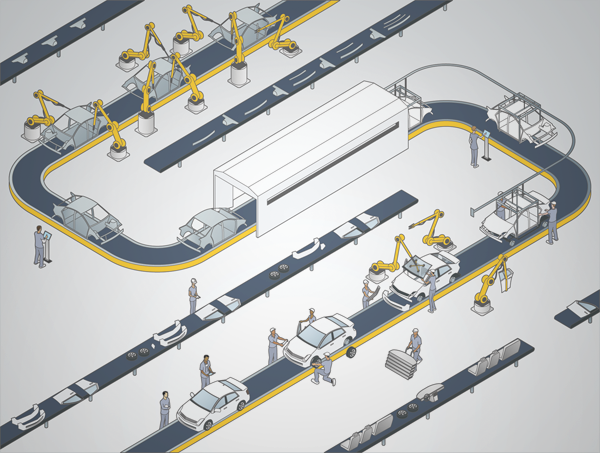
Unfortunately most of the organizations do suffer from many learning disabilities. According to Peter Senge, one good example is “enemy is out there“. What it means is that when things fails, organizations find outside thing(s) to blame. For example when sales are lower, companies blame it to the current economic conditions (outside factor) over inefficient selling process (internal factor). Making the sales process efficient could have still yielded more results at the given economic situation. The enemy out there factor limits opportunity to correct the selling process. In generic terms these learning disabilities limits the “opportunity to learn“.
We need to overcome these learning disabilities to truly find the organization that learn!
The concept of “Learning organization” is an emerging concept and it will take time to mature. But the potential of what it offers is promising to explore further. Learning organization is just a term and there is not much value in looking at the definition. What is interesting is to explore the five discipline of a learning organization. Therefore a good definition for the learning organization is an organization that recognizes and practices the following five disciplines.
Note: The discipline here means an area of practice. For example psychology is a discipline so as quantum physics.
Disciplines of a learning organization
- Systems thinking: Ability to see the whole
- Personal mastery: The process of life long learning
- Shared vision: A vision that shared & committed by everybody
- Mental model: Generalized & assumed view of how the world works
- Team learning: The process of developing the ability to create the desired results as a team
What is in it for us?
What it store for us is the simple fact that these disciplines touches the heart of agility. Agile software development is based on empiricism and therefore does not offer a consistent framework for practice. The learning organization disciplines provides a good foundation to truly practice agile software development. In other words agile movement guides us on what we need to do and learning organizations disciplines provides ways to how to practice.
Let’s explore how it works;
Systems thinking
What systems thinking tells us is to take a holistic approach rather than a component or event oriented view. The second important fact is that we are just part of the system & components in the system regularly exchange feedback. System archetypes provides a structure to understand the systems in operation and how to take the best view. In summary it is the system structure that causes its behavior. A good read on systems thinking can be found here. http://www.thwink.org/sustain/glossary/SystemsThinking.htm
If you think further on this line, you will realize that whole Agile movement is all about taking the systems thinking view.
In prior agile era, we had many phase gates and we had different teams such as business analysis, designers/architects, developers, etc. to perform a single operation of software development. At that time the whole software engineering was a disintegrated & event driven operation.
What agile movement brought in to software engineering was the systems thinking. No longer we have separate events like specification sign-offs, etc. Now we have same team performing different components in software engineering. Today we optimize & find solutions to the whole. For example we invite business people for the retrospectives and to demos. We optimize the feedback mechanisms and increases the frequency of feedback to single iteration. So the agile movement changed the whole structure of the software engineering thus creating a total different behavior. Simply we as agilists ride on top the systems thinking.
So now the question is: Are we done with systems thinking by inventing agile? Not really. Systems thinking discipline can take us much further than what we are today due to many reasons.
First reason is that today many organizations applies agile methods simply as a process and does not understand what agile thinking brings to the table. In this case the discipline of systems thinking can bring them back to some light.
Second reason is that use of systems archetypes can make the organizations to better understand how software development system works and to find the optimal way to operate. Remember every organization is different.
There are many other concepts inside systems thinking discipline such as point of high leverage, reinforcing/balancing feedback, etc. which can help an organization to find the true agile organization or take it to the next level.
Personal mastery
Personal mastery is the process of life long learning to achieve results we truly desire in our life. It is about being master of the what we do. The key to personal mastery is to find the a concept called “Creative tension” which will drive us forward. A further reading on personal mastery: https://www.solonline.org/?page=PersonalMastery
Agile software teams are self managed and consisted of motivated individuals who seeks excellence in whatever they do. Ceremonies such as retrospective look in to what learning which team take forward. Targets such as sprints goals clarifies teams of what they need to achieve. To take out few lines from Agile manifesto principles;
“Build projects around motivated individuals. Give them the environment and support they need, and trust them to get the job done”
“Continuous attention to technical excellence and good design enhances agility”
The discipline of personal mastery provides a framework to team members to improve their skills which requires in Agile software development.
Shared vision
Shared vision is a vision which the whole organization is committed. Shared vision touches heart of the organization and everybody in the organization shares the same vision.
The vision that is shared is by whole organization aligns it towards the excellence. When you look at the agile manifesto, aligning to business vision is the core focus of agile software development. Again to take few lines from agile manifesto
“Responding to change over following a plan”
“Our highest priority is to satisfy the customer through early and continuous delivery of valuable software.”
“Welcome changing requirements, even late in development. Agile processes harness change for the customer’s competitive advantage.”
Software development teams need to share the vision in order to see the value of welcoming changes even in late in development. When teams share the same vision as business, the highest priority would be to satisfy customer demands would happen automatically.
So the discipline of shared vision provides a framework to help software engineering teams to create, commit & share the organizational shared vision in the true agile organization.
Mental model
Software development is all about making abstractions about real world. Take an example of an order processing software. Order processing happens physically in a factory and software development teams needs to model it successfully to create a valuable piece of software. Object Oriented Programming concepts helped a great deal for software engineering to come to the place where we are today.
In definition Mental models are the abstractions which we make about real life situations. Mental models exists in minds of people and they exists below the level of conscious so people doesn’t realize the existence of mental model. Human forms mental models for everything. For example we build an abstract model in our mind regarding an upcoming version of Windows or year end Agile conference. We form these models based on limited information we tend to hear or find from somebody or somewhere. There is no guarantee that our mental are right and mental models are never accurate. What is important to be aware of mental models and test them.
Extending above example of order processing, let’s look how the mental models works. When the teams looks for requirements, they talk to people who does the order processing. Order processing people describe the process using abstractions. I.e. they describe their mental model of order processing. Then software developers creates another mental model inside their mind.
What agile movement did was to align with the formation of mental models and make them visible as much as possible. For example we use user stories over lengthy documentations so we don’t fix a wrong mental models. (Note: According Mike Cohn the abstraction of user stories provoke the discussion – which is a very good way to test the mental models)
We use personas to model the real users and we use “As a … I want to … So that …” format to model the real user scenarios & importantly understand the story behind the story. Agile architecture is about modeling the software based on what we know and keep opportunity to improve it as we go rather than fixing a wrong mental model. Concepts like sprint planning, sprint reviews, fast feedback, etc. provides opportunities to explore the mental models further. In waterfall we fix the model and it will be very hard to change.
Although agile movement touches the concept of mental models but the discipline of mental models offer far fetched benefits than what we use today. In my view we can use the discipline of mental model to create a new way of working to review & test the mental models which we form over user needs or requirements.
Team learning
Team learning is about learning as a team to create the results. Set of individual heroes does not always produce results unless they make a good team. The important fact to create a good team is that “team is able to learn as a team not only as individuals”.
Agile software development is based on teams not on individuals. We measure team velocity not individual velocity. We perform team retrospectives not individual performance reviews.
Agile manifesto specifies the need of the team but does not specify how to learn as a team (rightly so). There are many books written & many literature about how to create high-performing teams. But the discipline of team learning provides a different perspective based on systems thinking to practice how to work best as a team.
Conclusion
Agile organization is the one we all are dreaming to work for. Learning organization is what it helps to create the true agile organization.
As noted earlier, agile movement provides guidelines regarding what to achieve & learning organization disciplines provides how to do that.
And the true agile organization is just one benefit of the learning organization.
Further reading
http://newtechusa.net/agile/agile-gateway-drug-to-the-learning-organization
http://www.amazon.com/The-Fifth-Discipline-Practice-Organization/dp/0553456342














